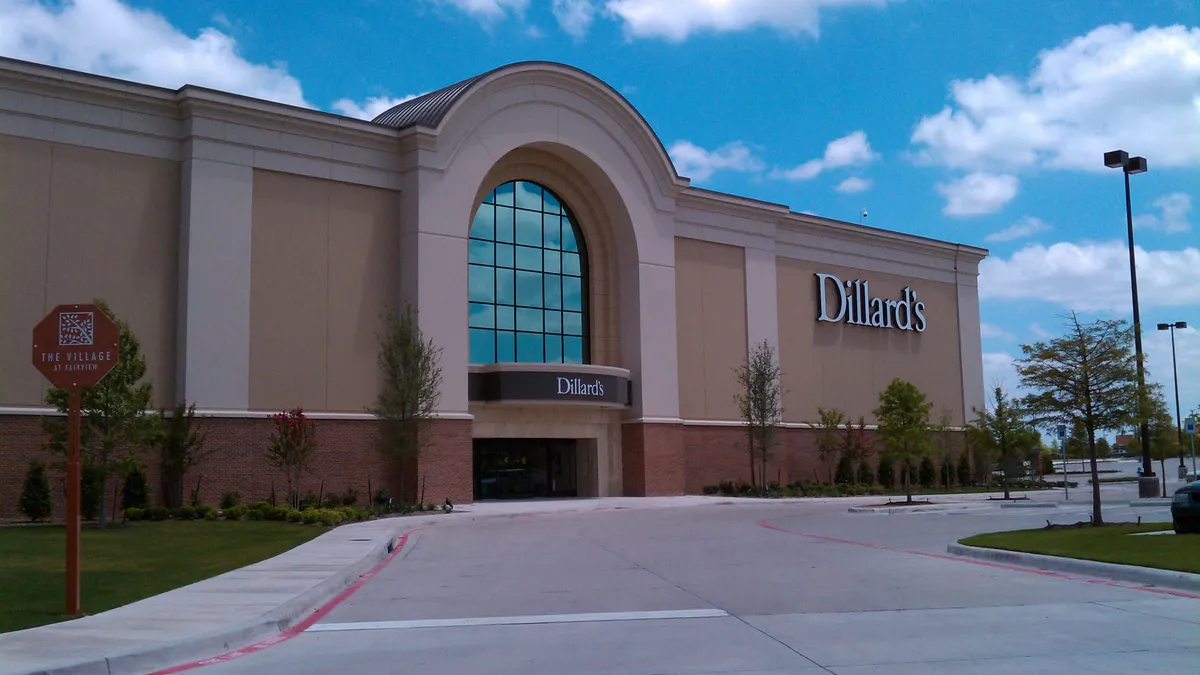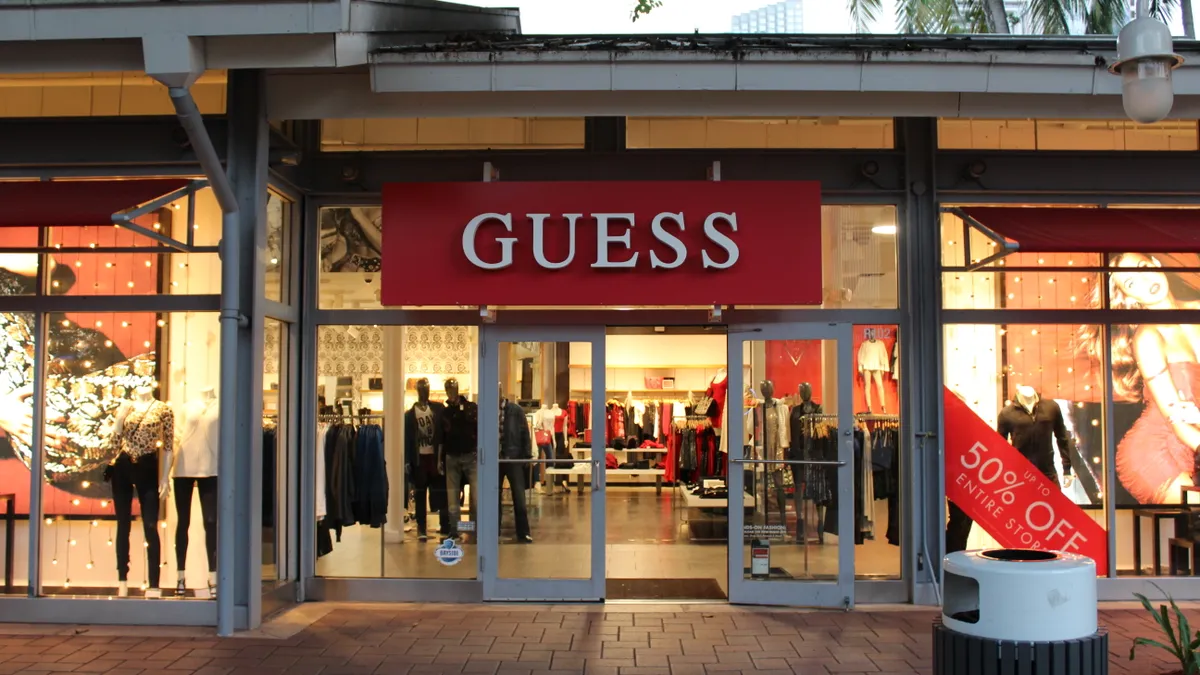Dillard's, a relatively youthful department store at 81 years old compared to many of its peers founded in the 19th century, is a Southern institution with a support system that includes a loyal customer base, firm family control and a whole lot of real estate.
The Arkansas-based company runs 260 full-line stores and 29 clearance centers spanning 29 states, mostly in the South and Southwest. Like rival Nordstrom, Dillard family members (who have the added advantage of control through Class B stock) run the C-suite, with eight in key positions, including chief executive. Like Macy's and Hudson's Bay Co., it's a major property holder, owning some 44.3 million square feet out of the 49 million in its operations, according to its most recent annual report.
"Though they are public, the Dillard family controls a separate class of voting stock which enables them to avoid, to a degree, activist intrusion and Wall Street's quarter by quarter performance demands," Columbia University Business School retail studies professor Mark Cohen told Retail Dive in an email. "The company is run in many ways as if it were private."
That would seem to give it a lot of leeway in terms of innovation. Yet, unlike Nordstrom or even Macy's, Dillard's doesn't appear to have much appetite for experimentation. While those retailers toy with store formats (like Nordstrom's Local concept) and in-store partnerships and presentation (like Nordstrom's pop-ups and Macy's Story), Dillard's stores are recognizable to anyone who ever set foot in a department store in the last century.
"One of the main features of Dillard's is that it's a very traditional business and it hasn't evolved much over the past 10 years," GlobalData Retail Managing Director Neil Saunders told Retail Dive in an email. "That lack of progress is mitigated by the fact that the chain has a reasonably loyal customer base — which tends to be older — and that they have made a point of investing in stores and customer service. So when you visit a shop it does not have the down-at-heel feel of most other department store chains. However, not moving forward is causing quite a few issues."
Loyalty
Dillard's didn't return Retail Dive's repeated requests for comment for this story. But the company's annual report reveals confidence in its conservative, even unadventurous approach. In the introduction, CEO and Chairman of the Board William Dillard II and President Alex Dillard, both sons of founder William T. Dillard, noted that "wars, recessions and other circumstances" have all challenged retailers in the past.
"We believe our conservative fiscal policy, currently evidenced by our fortress balance sheet, enabled us to survive while other retailers failed," they wrote. "We are in another such difficult time for U.S. department store retailing. The introduction of eCommerce and other retail innovation in our lifetime has changed the game as we know it. Multiple store closures and bankruptcies by those unable to keep pace were common in the 2018 financial headlines. While the sentiment surrounding our sector has been negative, we see positive things for retailers of strength and excellence. We believe Dillard's is such a retailer."
Their customers' expectations for well-curated fashion is a clear motivation, and that shows up in its private labels, according to Gonca Soysal, assistant professor of marketing at the University of Arkansas' Sam M. Walton College of Business. But, although those brands, notably Antonio Melani, among others, are strong, the collections could use some editing, she also said.
"I think the family gets in its own way. I think they're good merchants, but the consumer's changing so fast, and that's not really what they're good at."

Jen Redding
Analyst, Wedbush
"They have so many private brands, maybe 20 or 30 of them at least," she told Retail Dive in an interview. "Focusing of the merchandise would help customers, who are looking for a simpler, more joyful shopping experience."
Dillard's overall attitude may be what makes them good merchants in the eyes of many analysts, including Cohen, who said that Dillard's team are better store merchants, who "maintain and staff their stores better," than Macy's.
Nick Egelanian, president of retail development firm Siteworks, agrees. "Dillard's primary advantage is that the company, which has a long history of hands-on family management, still has family involved in a very hands-on way," he told Retail Dive in an email. "This allows the company to be far more in touch with what customers are thinking and make adjustments to the merchandise assortment and store operations proactively and efficiently."
It's a coin with two sides, advantages and disadvantages, however, according to Wedbush analyst Jen Redding. "They're good merchants for a baby boomer and the more traditional department store shopper. They're not good at speaking to millennials and I don't think they want to be."
That's showing up in results. In its most recent quarter, Dillard's disappointed investors as merchandise sales fell 2% year over year to $1.38 billion and net loss widened to $40.7 million from $2.9 million. Store comps also fell 2%, versus the 1% gain the year before as retail gross margin declined 319 basis points, according to a company press release. The profit squeeze in the quarter came from bloated inventory, according to Moody's Investors Service, which noted that "Macy's and Dillard's experienced the greatest gross-margin declines at 163 and 303 basis points, respectively," according to a report emailed to Retail Dive. "This destabilization of gross margin, fueled by below plan sales, overshadowed the continued focus on delivering cost efficiencies."
Dillard's position in the middle — neither in luxury like Neiman Marcus or Nordstrom nor discount like J.C. Penney or Kohl's — could also be muddling their message, Soysal said. "It's a positive, but it may cause some confusion," she said.
The resistance to innovation could be losing Dillard's customers, particularly younger ones, even as it caters to stockholders. In the six months ending Aug. 3, the company returned $71.5 million to investors through share repurchase and dividends.
"Dillard's staid nature means that it is falling further and further behind rivals in the market," Saunders warned. "It rarely does anything adventurous and the whole operation feels tired and dated. There is no clear path to future growth. Dillard's has kept shareholders happy by returning cash; however, arguably that capital should have been used for future investment."
That includes finding ways to use their stores to their advantage, according to Soysal. "Some of their competitors are doing a little better than them at that. At Nordstrom if you buy things online you can pick them up in the store, or if you can't find a size they can easily offer it to you," she said. "These things create big advantages, and if Dillard's has that they don't advertise it. They're heavily selling categories that require physical examination before purchase, and they really need to invest in that interaction."
Land and location
Dillard's vast real estate ownership has threatened to overshadow its retail. Two years ago, activist investor Snow Park Capital Partners called on the company to unlock the value of its holdings, deeming it "essentially an underleveraged real estate company that is masquerading as a low productivity retailer."
Indeed, the company owns so much property that in 2011 it created a real estate investment trust. But with so much of it tied to malls, and so many malls in decline, the value of its property isn't necessarily the pillar of support it once was, according to a recent client note from Wedbush's Redding. "Their real estate portfolio is bound to get lower," she told Retail Dive.
But its real estate also holds other problems more closely tied to its retail prospects: Its stores are too large and there are too many of them, experts say. "Their stores are really big, I mean humongous, and they're piled up with merchandise and so many options," Soysal said. "That was probably a positive back in the day, but these days customers want to get in and get out. I think this is a point of friction that should be simplified."
Paring down its footprint would allow the company to operate in areas where it has the best chances, she also said. "Dillard's has a really strong presence and focus on the South and they could use their monopoly advantage in small towns, that gives them a lot of opportunity where we don't have a Nordstrom."
The company is taking action, at least to some extent. This year Dillard's announced closures in Oakwood Mall in Enid, Oklahoma (70,000 square feet), Cary Village in Cary, North Carolina (145,000 square feet) and Mall of the Bluffs in Council Bluffs, Iowa (Clearance Center — 100,000 square feet).
But that's not likely the end of it. Dillard's "will need to continue to downsize and adapt" in what Egelanian calls the "post-department store era."
"Many of the malls it operates in are disappearing and consumers now have countless options available to purchase off-price soft goods," he said. "Look for Dillard's to steadily downsize as the shift away from malls and department stores enters its final phase — a phase in which Sears and J.C. Penney will likely liquidate and Macy's is likely to disappear or substantially downsize."
Nevertheless, Cohen, Egelanian and Soysal all expect Dillard's to be among the survivors in the space. In that company, Cohen does see Macy's, along with Belk and Western chain Von Maur also hanging on, with Lord & Taylor and J.C. Penney possibly slipping from view. Egelanian says Nordstrom will also endure — but that none will in their present state.
"While Dillard's is likely to survive, like Nordstrom, it will do so as a significantly smaller company in a much smaller industry when the dust settles in the long run," Egelanian said.






















